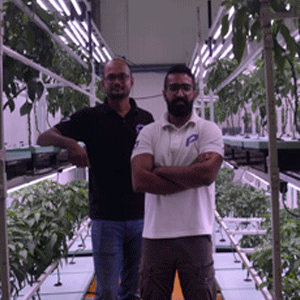
Year on year, traditional farmers are losing their crops to unseasonal rain, excess heat, and this problem is only going to exacerbate with every coming year. Global temperatures have already soared past the 1.5°C threshold, and by the time it hits 3°C higher, the outdoor yields will drop by over 32 percent according to a study done by NASA.
For smallholder farmers, this erosion isn’t theoretical, it shows up as lost harvests and shattered incomes. Addressing the urgency to rethink the mechanics of food production with a fogponics-based model of soilless farming is Purple Farm.
When the prototype of Purple Farms was sketched on a lab table in 2018, it wasn’t a startup chasing the next agritech trend. It was a technical response to a steadily eroding certainty, of whether tomorrow’s crops could withstand tomorrow’s climate. The solution is fogponics, a lesser-known but highly precise method of indoor soilless cultivation.
It delivers nutrients as a fine mist, just 10–15 microns in droplet size, allowing for faster root absorption and faster crop development. “This precision allows us to reduce water usage by 97 percent, grow tomatoes with 40 percent higher weight and Brix value, and cut crop cycles by up to 70 percent”, says Brahmmjyot Singh Kalsi, Founder, CEO & Managing Director, Purple Farms.
From Closed Systems to Open Possibilities
The company does not merely build high-tech farms, it builds entire operational models.
Whether a warehouse in Bangalore or an idle polyhouse in Ahmedabad, the company provides a full-stack solution, consisting of design, technology leasing, staff training, IoT-enabled remote monitoring, and access to a sales channel.
“Our infrastructure is 95 percent automated, with human intervention required only at points like germination, planting, and harvesting”, says Satya Raju, Co- Founder, Director & COO, Purple Farms.
This model is especially valuable in urban and semi-urban settings where land is scarce but infrastructure is often underutilized. Clients can repurpose old buildings into food production units without worrying about external variables like rainfall or soil quality. By stacking units vertically and enriching environments with controlled CO₂, it maximizes yield per square foot while minimizing environmental strain.
Purple Farms has iterated through six generations of its proprietary systems, transitioning from low-pressure aeroponics to fogponics after discovering the limitations of traditional spray methods. While aeroponics often disrupts delicate root systems due to higher droplet size, fogponics enables better nutrient uptake across a broader range of crops, including root vegetables that hydroponics cannot grow.
Decentralizing Control, Localizing Supply
The real proposition behind Purple Farms is predictability. Its indoor systems grow crops 365 days a year without using pesticides or herbicides. Produce is sold directly to the customer, bypassing warehousing and artificial price controls. Purple Farms’ crops are sold at fixed prices, independent of market fluctuations, giving buyers clarity and consistency.
Purple Farms’ crops are sold
at fixed prices, independent
of market fluctuations, giving
buyers clarity and consistency
Beyond that, hyper-local cultivation means produce can be grown closer to the point of consumption. This reduces carbon footprints, shortens delivery times, and extends shelf life: cherry tomatoes last 15 days outside the farm, as opposed to the traditional 10. Nutritional value, too, sees measurable gains: lab-tested results show up to 3x improvement over soil-based methods, attributed to precise nutrient delivery and minimal environmental stress on plants.
While its systems are already deployed in India, the company is eyeing expansion in the Middle East and Europe, regions where either water scarcity or food import dependency creates fertile ground for indoor farming. Purple Farms’ model offers a pathway for countries to localize high-value crops, reduce freight emissions, and regain some degree of food sovereignty, all with infrastructure that runs on affordable energy and low water input. It does not claim to replace traditional agriculture but offers a way to redistribute the load.
We use cookies to ensure you get the best experience on our website. Read more...